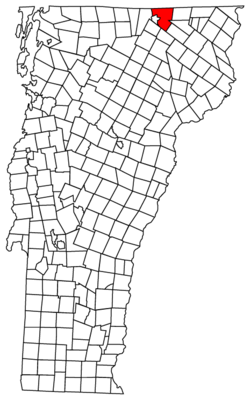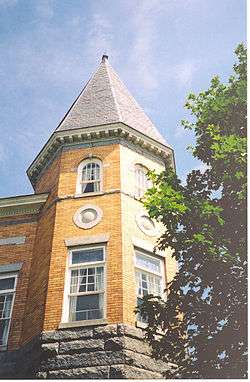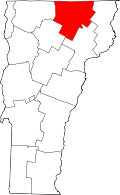Derby Line, Vermont
| Derby Line | |
|---|---|
| Village | |
|
Haskell Free Library and Opera House | |
 Location of the town of Derby in which the village is located. | |
| Coordinates: 45°00′17.98″N 72°05′57.97″W / 45.0049944°N 72.0994361°W | |
| Country | United States |
| State | Vermont |
| County | Orleans County |
| Town | Derby |
| Organized | June 16, 1977 |
| Area | |
| • Total | 0.7 sq mi (1.9 km2) |
| • Land | 0.7 sq mi (1.9 km2) |
| • Water | 0.0 sq mi (0.0 km2) |
| Elevation | 1,056 ft (322 m) |
| Population (2000) | |
| • Total | 776 |
| • Density | 1,057.5/sq mi (408.3/km2) |
| Time zone | EST (UTC-5) |
| • Summer (DST) | EDT (UTC-4) |
| ZIP code | 05830 |
| Area code(s) | 802 Exchange: 873 |
| FIPS code | 50-17500[1] |
| GNIS feature ID | 1457154[2] |
Derby Line is an incorporated village in the town of Derby in Orleans County, Vermont, United States, slightly north of the 45th parallel, the normal U.S.-Canada boundary. The population was 776 at the 2000 census.
The village is located on the Canada–United States border and is contiguous with the district of Rock Island in the town of Stanstead, Quebec.[3]
Notable buildings include the Haskell Free Library and Opera House.
History
The village was incorporated in 1791.[4] It lies on an elevation at the far north of Derby, which was chartered on October 29, 1779 and first settled in 1795. By 1859, the area was noted for the beauty of its farmhouses and luxuriant farmland, set before the distant vista of Lake Memphremagog and the Green Mountains.[5]
Because of an erratic survey, the border separating Canada from the United States was drawn incorrectly by the surveyors in the 18th century, above the 45th parallel which was the agreed boundary. Derby Line was founded based on that line, above the 45th parallel. The boundary was confirmed by the Webster–Ashburton Treaty in 1842.
Derby Line is known for the Haskell Free Library and Opera House, deliberately constructed on the international border and opened in 1904. The donors were a binational couple: Carlos F. Haskell was a local American businessman who owned a number of sawmills, while Martha Stewart Haskell was Canadian. The intent was that people on both sides of the border would have use of the facility, which is now a designated historic site. Patrons of the library from either side of the border may use the facility without going through border security.[6]
An entire tool-and-die factory, once operated by the Butterfield division of Litton Industries, is divided in two by the border.[7] The factory in Canada closed in 1982 after a lengthy strike by Canadian workers.[8] The factory in Derby Line is open. It was bought in 1988 by Group Tivoly, a cutting tools company based in France.[9]
Geography
According to the United States Census Bureau, the village has a total area of 0.7 square miles (1.8 km2), all land.
There are ramifications of living directly on the border of another country. For example, the US Border Patrol expressed a desire to close off streets which have historically run together with those of Stanstead. They are concerned about illegal immigration. In 2007, the village met with the Mayor and Council of Stanstead in joint session in Québec, to be addressed by the authorities. That is, the village trustee meeting was held in a foreign country, following Vermont procedural rules.[10][11]
In some places, the international border runs through individual homes, so that meals prepared in one country are eaten in the other.
A telephone call between Derby Line, Vermont and Rock Island, Québec is local.[12]
Demographics
| Largest ancestries (2000) | Percent |
|---|---|
| American | 17.6% |
| English | 17.0% |
| French Canadian | 16.0% |
| Irish | 15.5% |
| French | 13.1% |
| Italian | 7.4% |
| German | 4.4% |
| Scottish | 2.3% |
| Historical population | |||
|---|---|---|---|
| Census | Pop. | %± | |
| 1900 | 309 | — | |
| 1910 | 390 | 26.2% | |
| 1920 | 640 | 64.1% | |
| 1930 | 683 | 6.7% | |
| 1940 | 661 | −3.2% | |
| 1950 | 767 | 16.0% | |
| 1960 | 849 | 10.7% | |
| 1970 | 834 | −1.8% | |
| 1980 | 874 | 4.8% | |
| 1990 | 855 | −2.2% | |
| 2000 | 776 | −9.2% | |
| 2010 | 673 | −13.3% | |
| Est. 2015 | 651 | [13] | −3.3% |
As of the census[1] of 2000, there were 776 people, 329 households, and 225 families residing in the village. The population density was 1,057.5/sq mi (408.3/km2). There were 364 housing units at an average density of 496.0 per square mile (192.5/km²). The racial makeup of the village was 96.78% White, 0.39% African American, 0.90% Native American, 0.64% Asian, and 1.29% from two or more races. Hispanic or Latino of any race were 0.13% of the population.
There were 329 households out of which 31.6% had children under the age of 18 living with them, 52.6% were married couples living together, 11.6% had a female householder with no husband present, and 31.6% were non-families. 27.1% of all households were made up of individuals and 11.9% had someone living alone who was 65 years of age or older. The average household size was 2.36 and the average family size was 2.80.
In the village the population was spread out with 24.7% under the age of 18, 7.0% from 18 to 24, 25.6% from 25 to 44, 26.5% from 45 to 64, and 16.1% who were 65 years of age or older. The median age was 39 years. For every 100 females there were 92.1 males. For every 100 females age 18 and over, there were 86.0 males.
Economics
Personal income
The median income for a household in the village was $33,966, and the median income for a family was $37,375. Males had a median income of $30,208 versus $21,667 for females. The per capita income for the village was $15,202. About 11.4% of families and 12.8% of the population were below the poverty line, including 17.8% of those under age 18 and 11.9% of those age 65 or over.
Industry
A local subsidiary of an international tool manufacturer employs 180 workers from the area.[15]
Infrastructure
Roads
The village is the northern terminus of both Interstate 91 and US 5, which both continue northward into Québec as Quebec Autoroute 55 and Quebec Route 143 respectively.
Water
Drinking water for the adjacent towns of Derby Line and Stanstead is pumped from wells in Canada, stored in a reservoir in the United States and distributed through a system maintained by Canadians. Derby Line’s sewage makes a cross-border trip for treatment.[16]
Derby Line shares emergency crews with Stanstead. Each responds to calls on both sides of the border.
 View from station c. 1908
View from station c. 1908 The twin villages c. 1906
The twin villages c. 1906 Derby Line Hotel c. 1908
Derby Line Hotel c. 1908- Haskell Free Library on the US-Canada border, 2012
References
- 1 2 "American FactFinder". United States Census Bureau. Retrieved January 31, 2008.
- ↑ "US Board on Geographic Names". United States Geological Survey. October 25, 2007. Retrieved January 31, 2008.
- ↑ Austen, Ian (July 18, 2007). "Quebec and Vermont Towns Bond Over a Sleepy Border". The New York Times.
- ↑ Holland Historical Society (2004). Holland and Its Neighbors. Arcadia Publishing. p. 39. ISBN 0-7385-3614-8.
- ↑ Austin J. Coolidge & John B. Mansfield, A History and Description of New England; Boston, Massachusetts 1859
- ↑ Ring, William (May 25, 2007). "Border crackdown could hit binational library". Burlington Free Press.
- ↑ "History of Butterfield's". The Stanstead Journal. July 31, 1952.
- ↑ "Butterfield's: Important Invention Leads to International Factory | Townships Heritage WebMagazine". Townshipsheritage.com. Retrieved August 16, 2016.
- ↑ "Cutting tools". Tivoly INC. Retrieved January 25, 2012.
- ↑ Greeser, Joseph (May 23, 2007). "Border meeting set for Thursday". The Chronicle.
- ↑ "A border runs through it: Tiny town worries feds". CNN.com (AP). May 26, 2007. Archived from the original on June 18, 2007.
- ↑ "Local call finder". Local calling guide. July 31, 2016. Retrieved August 16, 2016.
- ↑ "Annual Estimates of the Resident Population for Incorporated Places: April 1, 2010 to July 1, 2015". Retrieved July 2, 2016.
- ↑ "Census of Population and Housing". Census.gov. Retrieved June 4, 2015.
- ↑ "Tivoly Inc (Tivoly, Inc) - Derby Line, Vermont (VT) | Company Profile". Manta.com. Retrieved January 25, 2012.
- ↑ New York Times retrieved July 3, 2009
External links
| Wikimedia Commons has media related to Derby Line, Vermont. |
- Town of Derby, Vermont
- Haskell Free Library and Opera House
- Derby Historical Society
- "Partly in Vermont: A borderline case". Time magazine. August 1979.
Coordinates: 45°0′17.98″N 72°5′57.97″W / 45.0049944°N 72.0994361°W

